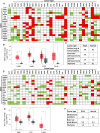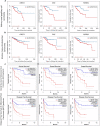Deep analysis of neuroblastoma core regulatory circuitries using online databases and integrated bioinformatics shows their pan-cancer roles as prognostic predictors
- PMID: 35201514
- PMCID: PMC8777518
- DOI: 10.1007/s12672-021-00452-3
Deep analysis of neuroblastoma core regulatory circuitries using online databases and integrated bioinformatics shows their pan-cancer roles as prognostic predictors
Abstract
Aim: Neuroblastoma is a heterogeneous childhood cancer derived from the neural crest. The dual cell identities of neuroblastoma include Mesenchymal (MES) and Adrenergic (ADRN). These identities are conferred by a small set of tightly-regulated transcription factors (TFs) binding super enhancers, collectively forming core regulatory circuitries (CRCs). The purpose of this study was to gain a deep understanding of the role of MES and ADRN TFs in neuroblastoma and other cancers as potential indicators of disease prognosis, progression, and relapse.
Methods: To that end, we first investigated the expression and mutational profile of MES and ADRN TFs in neuroblastoma. Moreover, we established their correlation with neuroblastoma risk groups and overall survival while establishing their extended networks with long non-coding RNAs (lncRNAs). Furthermore, we analysed the pan-cancer expression and mutational profile of these TFs and their correlation with patient survival and finally their network connectivity, using a panel of bioinformatic tools including GEPIA2, human pathology atlas, TIMER2, Omicsnet, and Cytoscape.
Results: We show the association of multiple MES and ADRN TFs with neuroblastoma risk groups and overall survival and find significantly higher expression of various MES and ADRN TFs compared to normal tissues and their association with overall survival and disease-free survival in multiple cancers. Moreover, we report the strong correlation of the expression of these TFs with the infiltration of stromal and immune cells in the tumour microenvironment and with stemness and metastasis-related genes. Furthermore, we reveal extended pan-cancer networks comprising these TFs that influence the tumour microenvironment and metastasis and may be useful indicators of cancer prognosis and patient survival.
Conclusion: Our meta-analysis shows the significance of MES and ADRN TFs as indicators of patient prognosis and the putative utility of these TFs as potential novel biomarkers.
Keywords: Core regulatory circuitry; Differentiation; Gene networks; Neuroblastoma; Solid cancers; Tumour microenvironment.
© 2021. The Author(s).
Conflict of interest statement
The authors declare that they have no competing interests.
Figures






Similar articles
-
Characterizing Relationships between T-cell Inflammation and Outcomes in Patients with High-Risk Neuroblastoma According to Mesenchymal and Adrenergic Signatures.Cancer Res Commun. 2024 Aug 1;4(8):2255-2266. doi: 10.1158/2767-9764.CRC-24-0214. Cancer Res Commun. 2024. PMID: 39099200 Free PMC article.
-
Adrenergic and mesenchymal signatures are identifiable in cell-free DNA and correlate with metastatic disease burden in children with neuroblastoma.Pediatr Blood Cancer. 2024 Jan;71(1):e30735. doi: 10.1002/pbc.30735. Epub 2023 Oct 20. Pediatr Blood Cancer. 2024. PMID: 37859597 Free PMC article.
-
T-cell inflammation is prognostic of survival in patients with high-risk neuroblastoma enriched for an adrenergic signature.bioRxiv [Preprint]. 2023 Jun 28:2023.06.26.546541. doi: 10.1101/2023.06.26.546541. bioRxiv. 2023. PMID: 37425883 Free PMC article. Preprint.
-
Recent advances in the developmental origin of neuroblastoma: an overview.J Exp Clin Cancer Res. 2022 Mar 11;41(1):92. doi: 10.1186/s13046-022-02281-w. J Exp Clin Cancer Res. 2022. PMID: 35277192 Free PMC article. Review.
-
Two bullets in the gun: combining immunotherapy with chemotherapy to defeat neuroblastoma by targeting adrenergic-mesenchymal plasticity.Front Immunol. 2023 Oct 2;14:1268645. doi: 10.3389/fimmu.2023.1268645. eCollection 2023. Front Immunol. 2023. PMID: 37849756 Free PMC article. Review.
Cited by
-
Gene expression in organoids: an expanding horizon.Biol Direct. 2023 Mar 25;18(1):11. doi: 10.1186/s13062-023-00360-2. Biol Direct. 2023. PMID: 36964575 Free PMC article. Review.
-
Neuroblastoma Interaction with the Tumour Microenvironment and Its Implications for Treatment and Disease Progression.Curr Oncol. 2023 Oct 15;30(10):9116-9140. doi: 10.3390/curroncol30100659. Curr Oncol. 2023. PMID: 37887559 Free PMC article. Review.
-
Cell types or cell states? An investigation of adrenergic and mesenchymal cell phenotypes in neuroblastoma.iScience. 2024 Nov 19;27(12):111433. doi: 10.1016/j.isci.2024.111433. eCollection 2024 Dec 20. iScience. 2024. PMID: 39687008 Free PMC article.
-
Mechanisms and molecular characterization of relapsed/refractory neuroblastomas.Front Oncol. 2025 Mar 6;15:1555419. doi: 10.3389/fonc.2025.1555419. eCollection 2025. Front Oncol. 2025. PMID: 40115016 Free PMC article. Review.
-
Bioinformatics Prediction for Network-Based Integrative Multi-Omics Expression Data Analysis in Hirschsprung Disease.Biomolecules. 2024 Jan 30;14(2):164. doi: 10.3390/biom14020164. Biomolecules. 2024. PMID: 38397401 Free PMC article.
References
-
- Brodeur GM. Neuroblastoma: biological insights into a clinical enigma. Nat Rev Cancer. 2003;3:203–216. - PubMed
-
- Maris JM, Hogarty MD, Bagatell R, Cohn SL. Neuroblastoma. Lancet. 2007;369:2106–2120. - PubMed
-
- van Groningen T, Koster J, Valentijn LJ, Zwijnenburg DA, Akogul N, Hasselt NE, Broekmans M, Haneveld F, Nowakowska NE, Bras J, et al. Neuroblastoma is composed of two super-enhancer-associated differentiation states. Nat Genet. 2017;49(8):1261–1266. - PubMed
LinkOut - more resources
Full Text Sources
Other Literature Sources
Miscellaneous
